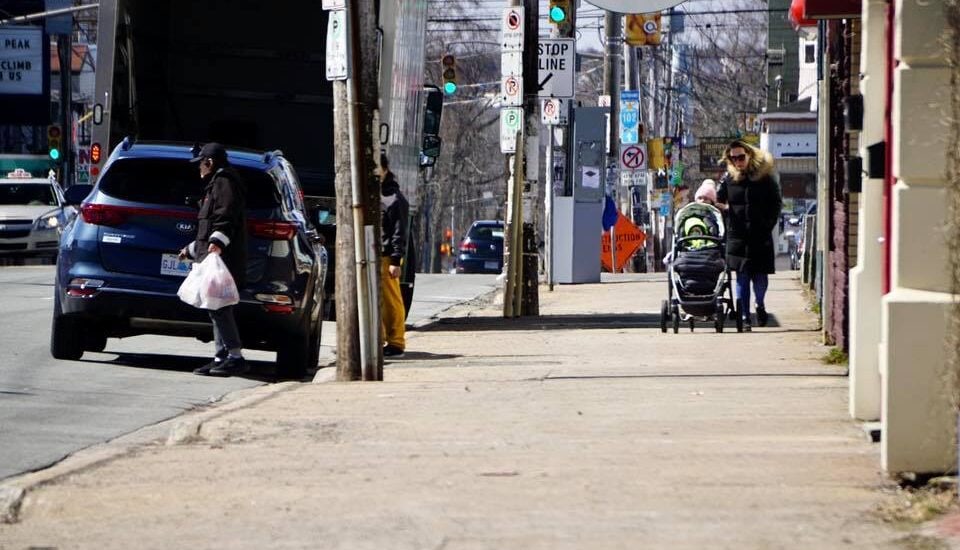
KJIPUKTUK (Halifax) – The death last week of 77 year-old Alfred Shaw in Summerside, PEI, struck by the driver of an Ford F-350 while out for a morning walk, is the latest in a long line of senior vulnerable road users killed or seriously injured on roads in Atlantic Canada that are unfit for elderly people to move around safely by foot and bicycle.
Little is known about the incident other than it appears to have happened at a wide intersection which offers no safety measures for pedestrians despite being right next to Elm Street Elementary School.
Summerside is no stranger to pedestrian danger – in January a truck driver hit a 61 year old pedestrian, resulting in critical injuries. In October 2018, local councillor Cory Snow tweeted;
“Traffic violations are one of the main concerns I hear as I go door to door in Ward 4. Specifically in the Elm Street Elementary School area.”
Roads that are wider than necessary in communities support endless speeding and careless driving. Occasional enforcement alone will not produce a long term or reliable change to behaviour. A school area must have infrastructure that prompts safe 30kph speeds, such as traffic calming measures used in snowy cities, and reducing road width by (for example) inexpensive school-led tactical urbanism.
This latest tragedy follows many other recent senior vulnerable road user fatalities in Atlantic Canada. Brief details of some (not all) are as follows;
- 74 year-old Dawn Nichol, who died February 18 after she was struck by a pickup truck driver while lawfully using a marked crosswalk on Dunbrack Street, Halifax.
- A 68 year-old Cole Harbour woman killed by a driver turning right on green at a Portland Street intersection while lawfully using a crosswalk on April 8.
- Seven additional pedestrian fatalities in Halifax since January 2018 including Glenn Stright (60), Willard Corneau (62) Joy Ruth Mendleson (69) and Gary Rogers (57). All seven victims were over 55 years old.
- 90 year-old Kenneth Luddington, struck and killed on April 30 while cycling on a road near a School in Auburn, Nova Scotia.
- 70 year-old Valerie Patterson, who died after she was struck on a crosswalk in Kentville, Nova Scotia last July.
- 81 year-old David MacLlean who died last May 1 after being struck while using a legal crosswalk on East River Road, New Glasgow. A 58 year-old pedestrian was also killed at East River Road on November 19 2018.
- A 63 year-old man who died after he was struck crossing a street in St Johns, Newfoundland on 4 January.
- A 70 year-old man killed after he was struck on a crosswalk in Moncton, NB, in December 2018.
- A 79 year-old lady killed September 2019 while crossing a road at Shediac Bridge, NB.
- 60 year-old Marjolaine Ward, killed after being struck on 27 August 2018 while cycling in Kildare Capes, PEI.

Seniors rely on walking or cycling for mobility because they may no longer drive for health reasons, or because it is the only way they can enjoy much needed exercise. But the infrastructure they use is built for vehicles to move quickly and easily, not to meet the safety requirements of vulnerable road users of all ages and abilities. The fatality locations (for example East River Road in New Glasgow) often have no adaptations or concessions whatsoever for the safety needs of vulnerable road users, built solely for ease of access and high capacity use by cars.
74 year-old Dawn Nichol had recently given up driving after she was involved in a car accident, and was adapting to using buses for practical journeys. She was on her way to the grocery store when she was struck and killed on a crosswalk known locally to be dangerous due to the wide road width and high speed of traffic.
Physically active 90 year-old Ken Luddington “took pride” in still being able to ride his bicycle and tragically died while cycling close to his home.
Enabling the elderly to walk and cycle locally and around shopping and service areas is extremely important. Safe local places to walk and cycle promote mental and physical health, can reduce health care costs and prevent isolation that results from being housebound. A walkable neighbourhood is essential for elderly people who rely on visiting friends and family, attending grocery stores and other essential journeys.
Although many communities in Atlantic Canada enjoy wide roads that support fast journey time and ease of movement by vehicle users, their safe use by people walking, cycling and using mobility scooters is clearly not a priority or even a consideration, particularly at road crossing points.
Common infrastructure deficiencies include;
- Very wide multiple-lane roads through communities and public service locations that are dangerous to use by vulnerable road users,
- No safety adaptations or traffic calming measures for communities on Provincial Highways,
- No sidewalks on wide roads which support high traffic speeds
- Crosswalks which are not safe by design;
Mid-block crosswalks are often too wide for safe use by pedestrians and expect pedestrians to negotiate multiple lanes that support high speeds of 50 to 80kph. They lack the safety features seen in Europe that meet the reduced physical abilities of an elderly population and disabled users, including the blind;
Dangerous signalized intersection crosswalks where protection may exist in theory through the legal requirement to yield, but not in reality. Right on red/green and left on green driver movements at traffic lights render it impossible for pedestrians of any age or ability to anticipate and avoid the danger caused by vehicle turning movements from multiple directions.

Atlantic Canada seniors are experiencing a mobility crisis. Decision-makers cannot just defer to engineers, be told our roads are compliant with standards and then leave the issue with them to resolve. Engineers may not account for the costs to our health-care system, quality of life, the variation of human ability due to age and disabilities, or the social need to understand and support elderly people’s mobility needs in their own community.
Decision makers must work together to ensure the levels of danger in communities are evaluated and assessed from an all ages and abilities road-user perspective, and identify what adaptations are required to effect safe mobility for all. A safe mobility strategy would also benefit children, people with disabilities and everyone else who would like the choice to walk, cycle or wheel in their own community.
The World Health Organisation urge decision makers to address the safe mobility requirements of seniors by ensuring “environments are pedestrian-friendly by using features such as high-visibility crossings, raised medians or pedestrian refuge islands; by reducing speed limits and installing traffic-calming measures; by keeping footpaths and kerbs well maintained (including using kerb cuts); by ensuring that overpasses and underpasses are accessible; by ensuring that signals at street crossings allow adequate time for crossing; and by providing auditory aids at crossings”
In Nova Scotia the level of danger for pedestrians has been considered previously in a 2007 report on Crosswalk Safety, and a comprehensive report from Child Safety Link in 2015. However many of the recommendations including modifications required to the built environment are not happening. Nor is there any obvious difference in approach or thinking regarding the need to implement widespread inexpensive adaptations, for example changes to traffic light timings to allow a safe protected time for pedestrians to cross the road.
If you are concerned by the lack of safety in your community, please write to your MLA and your municipal councillor enclosing this article and explaining your own safety concerns which prevent you from enjoying walking, cycling or wheeling where you live, or where you need to go.
Ask them if they will support and propose a strategic and independent assessment/audit of road infrastructure in your community for safe use by senior pedestrians, cyclists and mobility scooter users, as recommended by FHWA.
Ask that they support a provincial and municipal funded road safety action plan that adequately identifies and addresses the dangers identified. Redesigning each unsafe road or intersection will obviously be prohibitively expensive, so request that appropriate inexpensive countermeasures are identified as part of this action plan, for example simple crosswalk adaptations, road diets that include cycle lanes and reduce the number of traffic lanes, tactical urbanism, pedestrian refuge islands, resident-led traffic calming policies and inexpensive sidewalks. These are all mainstream solutions, recommended by traffic authorities and implemented in communities and cities throughout North America that have severe and widespread issues with dangerous by design roads.
If they decline to take further action or say these things are “happening already”, please provide their full response in the comments to this article and I will be very happy to provide support in the way of an appropriate follow-up response. And if you find this article some time after it has been written, it will likely still be relevant so do not hesitate using it for your advocacy.
If you walk, cycle or use a wheelchair and are affected by road safety issues, please join HRM Safe Streets for Everyone. If your local crosswalk needs a crosswalk flag, please contact the Crosswalk Safety Society. Please remember to report issues affecting your safety to our municipal authorities using the 311 service.
With a special thanks to our generous donors who make publication of the Nova Scotia Advocate possible.
Subscribe to the Nova Scotia Advocate weekly digest and never miss an article again. It’s free!




Thank you for this article. Is the size and design of these vehicles (SUVs and pickups) an issue ANY politician is willing to address? This is a common factor in so many of these fatalities.
Good question Margo, I believe the answer to that is a hard No. Politicians are not brave enough to restrict use of these vehicles in urban areas. However that does not mean they should urgently address the infrastructure issues that so commonly behind these vehicles seriously injuring or killing pedestrians and cyclists. If the drivers of them are required to move at slower speeds at intersections and crosswalks, they should present far less danger. Ample space to move and speed at key crossing points and urban communities is a recipe for incident after incident.